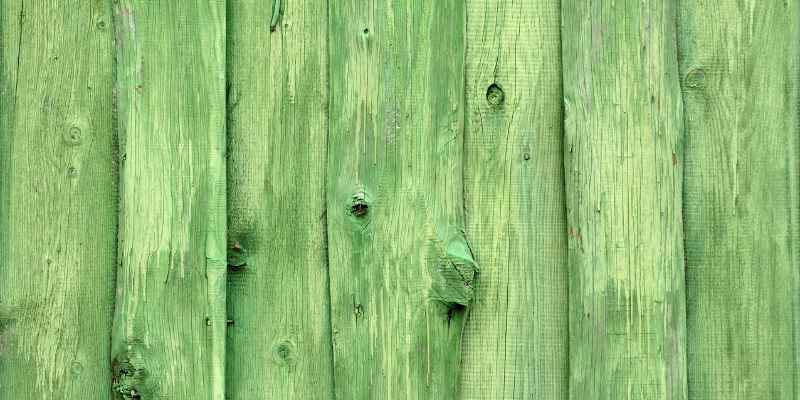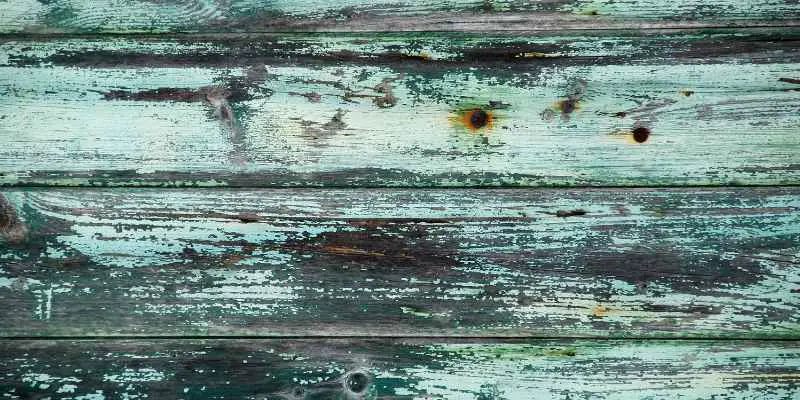Wood turns green due to the growth of algae, mold, or mildew on its surface, causing discoloration. The presence of moisture and lack of sunlight contribute to this phenomenon.
When left untreated, green wood can lead to rotting and deterioration, compromising the integrity of the wood structure. To prevent wood from turning green, proper maintenance, such as keeping the surface clean and dry, sealing cracks, and protecting against moisture, is essential.
Understanding the reasons behind wood turning green can help in taking proactive measures to preserve the wood’s appearance and longevity. By following these preventative steps, you can maintain the natural beauty and durability of wood materials for years to come.
The Science Behind Wood Turning Green
Wood aging is a natural process influenced by exposure to various elements.
Fungi and algae play a crucial role in the discoloration of wood surfaces.
Factors Contributing To Wood Turning Green
Wood turning green is a common occurrence, and there are several factors that contribute to this phenomenon. Understanding these factors is essential if you want to prevent or minimize the green discoloration of wood. In this section, we will explore three key factors: moisture content, exposure to sunlight, and the type of wood.
Moisture Content
One of the primary factors that contribute to wood turning green is its moisture content. When wood is exposed to high levels of moisture, it becomes a prime breeding ground for algae and other microorganisms that thrive in damp environments. These microorganisms, particularly green algae, can cause the wood to develop a greenish hue over time.
To prevent this, it is crucial to keep the wood dry and well-ventilated. Proper sealing and regular maintenance can help maintain the moisture content at an optimal level, reducing the chances of wood turning green.
Exposure To Sunlight
Exposure to sunlight is another significant factor that contributes to wood turning green. Sunlight provides the energy necessary for the growth of algae and other microorganisms that cause discoloration. When wood is exposed to direct sunlight for extended periods, the UV rays can trigger the growth of these organisms, leading to green stains.
To minimize the risk, consider shading the wood or applying a protective coating that blocks UV rays. Regular cleaning and removal of debris can also prevent the accumulation of moisture and reduce the chances of wood turning green.
Type Of Wood
The type of wood used also plays a role in its susceptibility to turning green. Certain types of wood, such as cedar and redwood, contain natural oils and compounds that make them more resistant to microbial growth. These oils act as a natural deterrent against algae and other microorganisms, reducing the chances of green discoloration.
On the other hand, softwoods like pine are more prone to turning green due to their higher levels of moisture absorption. Choosing the right type of wood for your project can make a significant difference in preventing wood from turning green.
To summarize, the moisture content, exposure to sunlight, and type of wood are the primary factors contributing to the green discoloration of wood. By understanding and managing these factors, you can maintain the natural beauty of wood and prevent or minimize the undesired green appearance. Regular maintenance, proper sealing, and choosing the right wood for your project are essential steps in keeping wood looking its best.
Implications Of Green Wood
When wood turns green, it’s often due to the growth of algae or mold caused by moisture and lack of sunlight. This not only affects the wood’s appearance but can also lead to decay and weakening of its structure. Regular cleaning and sealing can prevent this, keeping the wood in good condition.
Structural Integrity
Green wood, or wood that has turned green due to algae or mold growth, can have implications for its structural integrity. The presence of green organisms on the surface of the wood can lead to moisture retention, which can cause the wood to rot and weaken over time. This can compromise the stability of structures made from green wood, such as decks, fences, or furniture.
Aesthetics
The appearance of green wood can also have aesthetic implications. The presence of algae or mold can make the wood look unattractive and diminish its overall appeal. Green stains or spots on wood surfaces can be particularly unsightly, detracting from the natural beauty of the material. Whether it’s a wooden deck, furniture, or a decorative item, the green discoloration can impact the overall aesthetics of the wood.
Potential Health Risks
In addition to structural and aesthetic concerns, green wood may also pose potential health risks. Mold and algae can release spores into the air, which can be inhaled and cause respiratory issues, particularly for individuals with allergies or asthma. Additionally, prolonged exposure to damp or rotting wood can create an environment conducive to the growth of bacteria and fungi, increasing the risk of infections or allergic reactions.
In conclusion, the implications of green wood include compromised structural integrity, diminished aesthetics, and potential health risks. It is important to address and prevent the growth of algae or mold on wood surfaces to maintain the longevity and visual appeal of wooden structures or furniture, as well as to ensure a safe and healthy environment.
Preventative Measures For Wood Turning Green

Wood turning green can be a common issue caused by factors like moisture and algae growth. By taking preventive measures, you can maintain the natural look and longevity of your wooden surfaces. Here are some effective ways to prevent wood from turning green:
Regular Cleaning And Maintenance
- Clean wood surfaces regularly to remove dust, dirt, and debris.
- Use a mild soap and water solution to wash the wood.
- Remove any algae or mold growth using a mixture of water and white vinegar.
- Ensure proper drainage to prevent water buildup on the wood.
Sealing And Protective Treatments
- Apply a quality sealant to protect the wood from moisture and UV damage.
- Choose a protective treatment that is suitable for the type of wood you have.
- Regularly inspect the wood for any signs of discoloration or damage.
- Reapply sealant or protective coatings as needed to maintain wood integrity.
By following these preventative measures, you can keep your wood looking fresh and vibrant, avoiding the green discoloration often associated with moisture and environmental factors.
Removing Green Stains From Wood
Discover effective methods for removing unsightly green stains from wood surfaces.
White Vinegar Solution
Mix one gallon of water with one cup of white vinegar to create a powerful cleaning solution. Scrub the wood surface with the mixture to eliminate algae, mold, and mildew.
Pressure Washing
If you prefer chemical-free cleaning, utilize a pressure washer to blast away green stains. This method effectively removes algae without the need for additional products.
Safety Precautions:
- Wear protective gear like goggles and gloves while pressure washing the wood.
- Avoid directing the pressure washer nozzle towards yourself or others.
- Follow manufacturer instructions for operating the pressure washer safely.
Common Misconceptions About Green Wood
When it comes to wood turning green, there are a few common misconceptions that need to be debunked. Understanding the true causes behind the green discoloration can help you take appropriate measures to prevent and treat it. Let’s take a closer look at some of these misconceptions:
Role Of Chlorociboria Fungus
One common misconception about green wood is that it is caused by mold or algae. In reality, the green coloration often comes from a fungus called Chlorociboria. This fungus is commonly found in damp, decaying wood, and it produces pigments that stain the wood green. Contrary to popular belief, the presence of this fungus does not necessarily signal decay or structural damage in the wood.
However, it is important to note that while Chlorociboria may contribute to the green discoloration, it does not cause structural damage to the wood. In fact, some woodworkers and artisans value the unique and aesthetically pleasing appearance that this natural staining creates.
Pressure-treated Wood Misconceptions
Another common misconception is that all green wood is pressure-treated. Pressure-treated wood is indeed treated with chemicals to protect it against rot and decay, but this treatment does not result in a green color. Pressure-treated wood typically has a light green or brown color due to the chemicals used in the treatment process.
On the other hand, the green discoloration seen in non-pressure-treated wood is primarily caused by environmental factors such as moisture and exposure to sunlight. These conditions create an ideal environment for fungi like Chlorociboria to thrive and produce the green staining.
In order to prevent the green discoloration of wood, it is essential to address the underlying causes. Properly sealing and protecting the wood from moisture can help prevent fungal growth and the resulting green coloration. Regular cleaning and maintenance can also go a long way in preserving the natural beauty of the wood.
| Common Misconception | Reality |
|---|---|
| All green wood is mold or algae-infested | Green discoloration is often caused by the Chlorociboria fungus |
| All green wood is pressure-treated | Pressure-treated wood has a different color due to the treatment chemicals |
By dispelling these misconceptions and understanding the true causes behind green wood, you can make informed decisions on how to address and prevent this issue. Remember that proper maintenance and protection are key to keeping your wood looking beautiful and green-free.
Artistic And Practical Uses Of Green Wood
Woodturning with green wood offers unique opportunities for creativity and craftsmanship. Unlike dried wood, green wood is softer and easier to shape on a lathe, allowing artisans to create intricate designs and forms.
Green wood is prized for its versatility in decorative applications. From hand-carved sculptures to custom furniture pieces, the natural green hues of the wood lend a rustic and organic charm to any space.
Conclusion: Embracing The Natural Aging Process

Wood turning green is a natural process caused by the growth of algae, mold, and mildew due to moisture and sunlight exposure. To prevent this, it’s crucial to keep the wood clean and seal any openings to avoid water damage and decay.
Removing green from wood can be achieved with vinegar and water solution or pressure washing.
Wood turning green is a natural and fascinating process that occurs due to various factors such as moisture, fungus, and algae. Rather than viewing this transformation as a problem, it’s important to appreciate the unique characteristics it brings to wood and embrace the natural aging process. By understanding the reasons behind wood turning green, we can better understand how to care for and maintain green wood while also utilizing it sustainably.
Appreciating The Unique Characteristics
One of the most interesting aspects of wood turning green is the unique characteristics it imparts. As wood ages and turns green, it develops a distinct weathered appearance that adds personality and charm to any application. Whether it’s a wooden deck, furniture, or decorative items, embracing the green hues can create a rustic, natural, and aesthetically pleasing look.
Furthermore, green wood often showcases beautiful patterns and textures, created by the growth of algae and fungi. These patterns add depth and visual interest to the wood, making each piece truly one-of-a-kind.
Sustainable Use Of Green Wood
Another reason to embrace the natural aging process of wood turning green is the opportunity for sustainable use. Instead of prematurely discarding green wood, which may still have structural integrity, we can find creative and eco-friendly ways to repurpose it.
For example, instead of replacing a green wooden deck, consider cleaning and sealing it to protect it from further moisture damage. This not only extends the lifespan of the wood but also reduces unnecessary waste.
Additionally, green wood can be repurposed into various DIY projects such as garden furniture, planters, or even artistic sculptures. By finding innovative ways to use green wood, you can contribute to sustainable practices and reduce your environmental footprint.
Remember, embracing the natural aging process of wood turning green allows us to appreciate its unique characteristics and find sustainable ways to use it. Whether it’s the weathered appearance or the opportunity for creative repurposing, green wood brings an element of natural beauty that should be celebrated.
Frequently Asked Questions Of Why Does Wood Turn Green
How Do You Remove Green From Wood?
Combine water and white vinegar, then scrub wood to remove green algae, mold, and mildew. Use a pressure washer as an alternative method.
Is Green Algae On Wood Harmful?
Green algae on wood is not harmful to humans, but it can make the surface look unattractive and can cause rot and weaken the wood. To remove green algae, you can use a mixture of water and white vinegar or pressure wash the wood.
Keeping the wood clean and sealing any cracks or openings can also prevent algae growth.
How Do You Keep Wood From Turning Green?
To prevent wood from turning green, keep the deck clean and free of debris to prevent moisture accumulation. Seal any cracks or openings to protect the wood from water damage. Additionally, treat early stages of green mold with a mixture of white vinegar and lukewarm water.
How Do You Get Green Off Treated Wood?
To remove green off treated wood, mix one cup of vinegar with a gallon of water and scrub the wood.
Conclusion
Wood turning green can be a natural process caused by algae growth due to moisture. Prevent this by keeping wood clean and sealed against water damage. Use white vinegar or pressure washing to remove green algae effectively. Preserving and protecting wood ensures longevity and aesthetics.
Embrace the beauty of natural wood while maintaining its quality.


